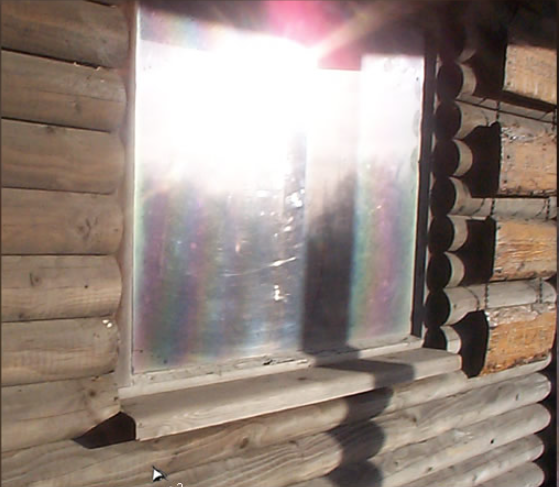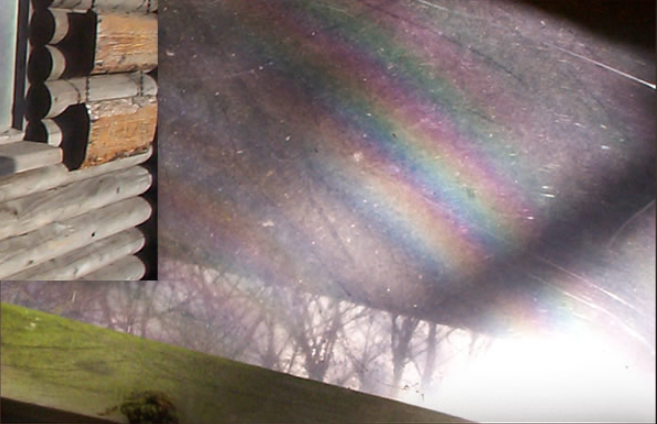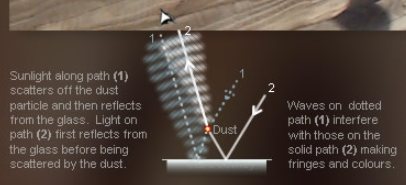Garden Shed Window
Garden Shed Window: Exploring the Colourful World of Atmospheric Optics
Have you ever noticed the mesmerizing play of colors on the dusty windows of a garden shed? Those seemingly ordinary dust particles can create a stunning display of vibrant hues. This captivating phenomenon is a result of the interaction between light waves scattered by the dust and reflected by the glass. In this article, we will delve deeper into the science behind this optical effect, known as Quételet fringes.
When sunlight reaches the dusty window, it follows two distinct paths. Along path (1), light scatters off the dust particles and then reflects from the glass. On path (2), the light first reflects from the glass before being scattered by the dust. These two sets of light waves eventually converge and interact with each other, giving rise to interference patterns and an array of beautiful colors.
The interaction between the waves traveling along paths (1) and (2) creates a phenomenon known as interference. As the waves meet, they either reinforce or cancel each other out, resulting in alternating bright and dark bands. These bands are called Quételet fringes, named after Adolphe Quételet, the Belgian mathematician who first described this type of interference pattern.
The colors observed in the Quételet fringes are a result of the constructive and destructive interference of light waves with different wavelengths. When waves reinforce each other, they create areas of bright light, while areas where waves cancel each other out appear dark. The specific colors observed depend on the wavelengths of light involved in the interference.
The dusty window acts as a canvas for this intricate display of colors. Each dust particle scatters and reflects light in its own unique way, contributing to the overall pattern of Quételet fringes. The varying sizes and shapes of the dust particles further enhance the complexity and beauty of the optical effect.
It is important to note that this phenomenon can occur not only on garden shed windows but also on any surface where dust particles are present. Whether it's a car window, a dusty bookshelf, or even a camera lens, the interplay between light and dust can create captivating visual displays.
While the Quételet fringes phenomenon is undoubtedly enchanting to behold, it also serves as a reminder of the fascinating world of atmospheric optics. These optical effects occur all around us, constantly reminding us of the intricate nature of light and its interactions with the environment.
In conclusion, the dusty windows of a garden shed offer us a glimpse into the captivating world of atmospheric optics. The interaction between light waves scattered by dust particles and reflected by glass gives rise to Quételet fringes, resulting in a mesmerizing display of colors. This phenomenon serves as a testament to the intricate nature of light and its interactions with the world around us. So, the next time you come across a dusty window, take a moment to appreciate the beauty that lies within its seemingly mundane surface.
Colour bands on dusty windows imaged by Kevin Boyle. Images ©Kevin Boyle, shown with permission.
Optical effects are everywhere. Here, dust particles on the windows of a garden shed produce a colour display. Light scattered by the dust and reflected by the glass reaches us along two routes. The two sets of light waves interact to produce coloured interference bands called Quételet fringes. More about Quételet scattering here.



Sunlight along path (1) scatters off the dust particle and then reflects from the glass. Light on
path (2) first reflects from the glass before being scattered by the dust.
Waves on dotted path (1) interfere with those on the solid path (2) making fringes and colours.
Note: this article has been automatically converted from the old site and may not appear as intended. You can find the original article here.
Reference Atmospheric Optics
If you use any of the definitions, information, or data presented on Atmospheric Optics, please copy the link or reference below to properly credit us as the reference source. Thank you!
-
<a href="https://atoptics.co.uk/blog/garden-shed-window/">Garden Shed Window</a>
-
"Garden Shed Window". Atmospheric Optics. Accessed on April 20, 2024. https://atoptics.co.uk/blog/garden-shed-window/.
-
"Garden Shed Window". Atmospheric Optics, https://atoptics.co.uk/blog/garden-shed-window/. Accessed 20 April, 2024
-
Garden Shed Window. Atmospheric Optics. Retrieved from https://atoptics.co.uk/blog/garden-shed-window/.